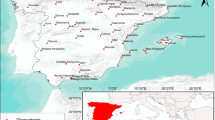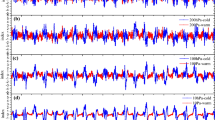Abstract
We calculated the fractal dimensions D b of the perimeter of tropical cyclone (TC) Dan based on the satellite GMS-5 infrared sensor images from 1800 UTC, 1 October 1999 to 1200 UTC, 9 October 1999. The fractal dimensions D b were used to characterize objectively the temporal change of TC complex structure. Our results show that the change of fractal dimension during TC Dan motion can be divided into three stages. The statistically significant difference does not exist either between D m1 and D L or between D m3 and D L, but it exists between D m2 and D L, where D mi denotes the mean value of D b in i-th stage (i=1, 2 and 3); D L denotes Lovejoy’s fractal dimension calculated based on satellite and radar data within the size range (1−1.2×106 km2), which is used as a “normal value” of the fractal dimension of the cumulus cloud perimeter for the global tropical region. TC Dan turns to the north from the west abruptly at the end of the second stage. The emergence of the second stage with high fractal dimensions may be viewed as a possible premonition for the track turning. Our results also show that there are two kinds of processes resulting in the translation from the first stage to the second stage. One is the interaction of TC circulation and an adjacent small scale convective cloud cluster, causing to the complexity increase of a local segment of the perimeter. The other includes the fragmentation of a strong convective area within the TC inner region, the self-organization of the small strong convective cloud clusters, the emergence, development, and merger of the small scale non-convective holes, and the formation of a gap of the perimeter, causing to the complexity increase of the whole TC perimeter.
Similar content being viewed by others
References
Bodenschatz E, Malinowski S P, Shaw R A, et al. 2010. Can we understand clouds without turbulence? Science, 327: 970–971
Cahalan R F, Joseph J H. 1989. Fractal statistics of cloud fields. Mon Weather Rev, 117: 261–272
Chen T C, Yen M C, Tsay J D, et al. 2012. Synoptic development of the Hanoi heavy rainfall event of 30–31 October 2008: Multiple-scale processes. Mon Weather Rev, 140: 1219–1240
Elsberry R L. 1995. Global Perspectives on Tropical Cyclones. Geneva: World Meteorological Organization
Elsberry R L. 2007. Recent advances in tropical cyclone track forecasting techniques that impact disaster prevention and mitigation. International Training Workshop on Tropical Cyclone Disaster Reduction, WMO, CASWGTM, Guangzhou, China. 1–7
Fu S M, Yu F, Wang D H, et al. 2013. A comparison of two kinds of eastward- moving meso-scale vortices during the Mei-yu period of 2010. Sci China Earth Sci, 56: 282–300
Galarneau T J, Hamll T M, Dole R M, et al. 2012. A multiscale analysis of the extreme weather events over Western Russia and Northern Pakistan during July 2010. Mon Weather Rev, 140: 1639–1664
Guo Z Z. 1965. Mathematics Statistics for Doctors (in Chinese). Bejing: People’s Medical Publishing House. 189–210
Huang Y, Krumanocker I, Coppens M O. 2012. Fractal self-organization of bacteria-inspired agents. Fractals, 20: 179–195
Lovejoy S. 1982. Area-perimeter relation for rain and cloud areas. Science, 216: 185–187
Luo Z H. 2001. The investigation of typhoon 9914 track using satellite cloud images and synoptic maps. Taiwan Straits, 20: 426–428
Luo Z, Liu C. 2007. A validation of the fractal dimension of cloud boundaries. Geophys Res Lett, 34: L03808, doi: 10.1029/2006GL028472
Luo Z, Liu C. 2008. A numerical study of multiple vortex self-organization as forced by mesoscale topography. Meteor Atmos Phys, 99: 65–76
Luo Z X, Ping F. 2012. Mechanism for initial brows-like meso-scale vortex effects on tropical cyclone track. Sci China Earth Sci, 55: 611–621
Luo Z X, Yu H, Ping F, et al. 2012. Fractal description of vortex axisymmetric process. Acta Phys Sin, 61: 244702-1–244702-6
Luo Z, Zhou X, Gao S. 2006. Two possible mechanisms for vortex self-organization. Sci China Ser D-Earth Sci, 49: 202–211
Ma Y, Wang S, Tao, Z Y. 1997. Survey and time-spatial distribution of meso-scale convective systems in China and its neighbours. Adv Nat Sci, 7: 701–706
Maddox R A. 1980. Meso-scale convective complexes. Bull Amer Meteoro Soc, 61: 1374–1387
Ng H D, Abderrahmane H A, Bates K R, et al. 2011. The growth of fractal dimension of an interface evolution from the interaction of a shock wave with a rectangular block of SF6. Commun Nonlinear Sci Numer Simulat, 16: 4158–4162
Siebesma A P, Jonker H J J. 2000. Anomalous scaling of cumulus cloud boundaries. Phys Rev Lett, 85: 214–217
Young I M, Crawford J W. 2004. Interactions and self-organization in the soi-microbe complex. Science, 304: 1634–1637
Zhang L, Dai B X, Wang G Q, et al. 2009. The quantization of river network morphology based on the Tokunaga network. Sci China Ser D-Earth Sci, 52: 1724–1731
Zhang R H, Tian J, Li Z L, et al. 2010. Principles and methods for the validation of quantitative remote sensing products. Sci China Earth Sci, 53: 741–751
Zhao S W, Zhao Y G, Wu J S. 2010. Quantitative analysis of soil pores under natural vegetation successions on the Loess Plateau. Sci China Earth Sci, 53: 617–625
Author information
Authors and Affiliations
Corresponding author
Rights and permissions
About this article
Cite this article
Luo, Z., Wang, Y., Ma, G. et al. Possible causes of the variation in fractal dimension of the perimeter during the tropical cyclone Dan motion. Sci. China Earth Sci. 57, 1383–1392 (2014). https://doi.org/10.1007/s11430-013-4745-8
Received:
Accepted:
Published:
Issue Date:
DOI: https://doi.org/10.1007/s11430-013-4745-8




